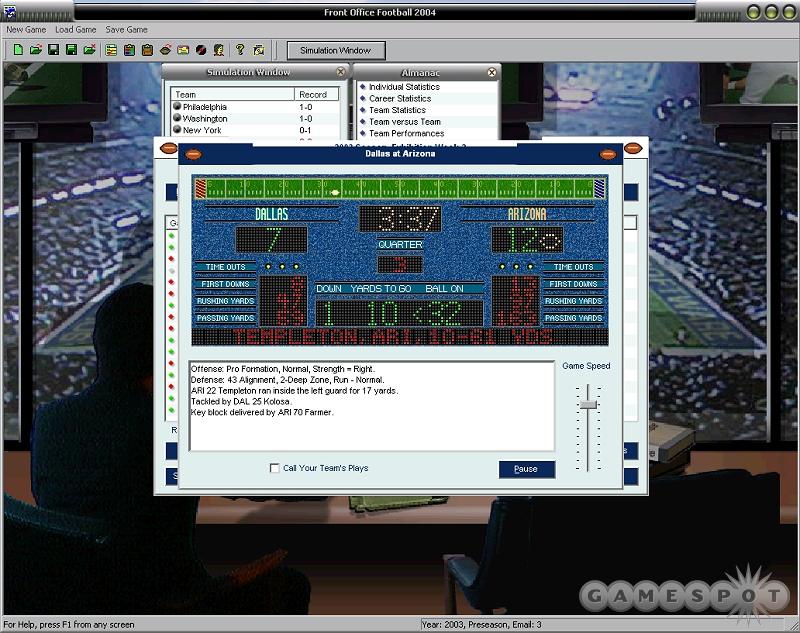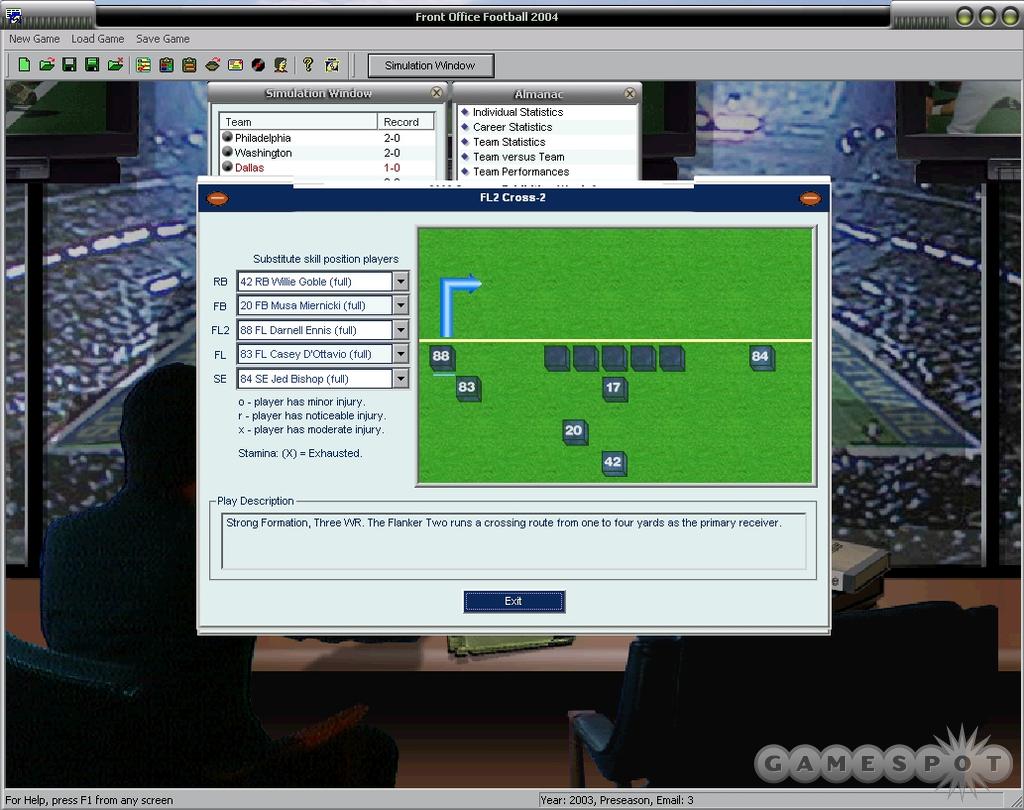In almost every way, Front Office Football 2004 is an improvement over its predecessor. Solecismic Software's text-based management sim (only available online at the developer's Web site) enters its fifth season with more than a dozen substantial additions to what's already the most rigorous re-creation of football from head office to huddle. Online league play and smart little tweaks, like contract holdouts and the ability to hire and fire offensive and defensive coordinators, make this the best game in the history of the series. The only lingering issues are dated presentation values and a somewhat obtuse interface. If this game had a bit more personality, it would approach perfection.

As it is, though, the experience is captivating for anyone who grew up wanting to turn Pop Warner dreams into reality. FOF 2004 is a remarkably complete look at running a professional football franchise. You take over the club of your choice and operate it from the top down for as many seasons as you like. Control can be exercised over every aspect of team operations, thus allowing you to interfere everywhere (à la Jerry Jones, the current owner/controller of the NFL's Dallas Cowboys) by permitting you to actually call plays, hire coaches, and trade/draft personnel to get the job done on the field.
Core gameplay remains virtually unchanged from past seasons, although a number of additions add texture to gameplay that is already deep. Offseasons are a lot more interesting now. Holdouts occur on a fairly frequent basis, so now you have to really look at a player before pulling the trigger on a trade. More than once our dreams of building a contender were shattered by an uppity young quarterback who simply wanted more money than we could afford to pay him. Even rookies occasionally refuse to sign. So you have to look at more than the raw numbers before handing out jerseys and caps on draft day.
Signing offensive and defensive coordinators from a limited pool also ratchets up offseason tension. Bidding is fierce for the top coaches, and you can never tell when a team is about to up the ante by offering a top coordinator a head coaching position. Free agency, as a whole, is actually more involved, thanks to a new eight-stage system that walks you through negotiations. This stretches out the bidding process by allowing more teams to get in on the action. Single bids simply aren't enough to get players to sign on the dotted line anymore. Top players get loads of attention, and the ensuing bidding war forces you to carefully look at salary cap issues. Somebody almost always has the cap room and cash to break the bank on the top free agents, so you really can't compete unless you're also willing to go to the wall. This limits the effectiveness of free agency, albeit in a way that mirrors the limited effectiveness of free agency signing in the real NFL, so you can't complain too much.
Aside from the odd, smart trade, drafting is the best way to build a team. FOF 2004 emphasizes this by adding a league combine, which is similar to the NFL's vaunted rookie camp, where top draft candidates are put through their paces by running the 40 and so on. It gives you more to consider on draft day. However, the extra numbers don't mean that drafting is without its pitfalls. As noted above, draftees can (and do) hold out for more money. And busts seem to occur more often than in previous editions of the game. A fair number of players just don't turn their projected ratings into reality in "the bigs." This, of course, could also mean that scouting quality is more varied and discretionary this year.
Multiplayer moves the game online in its entirety. League play supports up to 32 players, which means that you can run virtual NFLs over the Web. It functions in a similar way to Out of the Park Baseballs 4 and 5 in that you make personnel moves, set playbooks, and so forth before e-mailing a team file to the league commissioner, who then simulates the week's games. It seems nearly flawless in execution so far, although there are a few kinks to work out. For instance, individual teams could use password protection. As it is, you can look up classified information about competitors, like their previous weeks' game plans. Despite the problems, and judging by the Front Office Football Central forums, FOF 2004 online play is getting popular. Leagues always seem to be looking for players, so taking advantage of the multiplayer option is a snap, even if you don't personally know other people who play the game.
However, it remains hard to warm up to Front Office Football. The graphics are an antediluvian artifact of the DOS era. Even the main menu backdrop has changed little over the years. Of course, nobody expects a text-based game to come with a lot of visual bells and whistles, but the presentation here remains staid if not unfriendly. Unlike many other sports management sims, Solecismic doesn't walk you through seasons with obvious prompts. Although there are tips about big events, like the start of the free agency period that comes between seasons, you have to delve into the nested menu system to reveal other important news. For example, you're not told on the main screen or by the in-game e-mail system (which is sadly underused) when you've been outbid for a free agent. You have to go in to the free agency menu and look up the player to see if your bid still has a shot. While the cumbersome interface may require too many clicks, it is easy to navigate. It may take longer than necessary to get to your destination, but it is pretty hard to get lost.

And like its predecessors, FOF 2004 is as dry as the Gobi Desert. Even though players have been given more personality traits, there is very little personality communicated in the game. E-mails and scouting reports are more like point-form notes from a computer program than notes jotted down by human coaches. Even in trade negotiations, the dialogue is stilted and lifeless. Hearing that "This trade does not bring enough in return, according to your opponent's scouting staff," may tell you all you need to know, but something a little more colorful would be much appreciated. You soon start to miss the more distinctive characters that populate the likes of other management series, like Out of the Park Baseball. They, at least, tell you in no uncertain words when you're making ridiculous trade proposals, like demanding a first-round pick for a broken-down spare part in his late 30s.
Still, the great stuff at the heart of Front Office Football 2004 keeps you coming back. Although giving the game a human face would make playing it a much more personable--even a more realistic--experience, Solecismic is dead-on with all the core elements of play. There's no better simulation of big-league football.